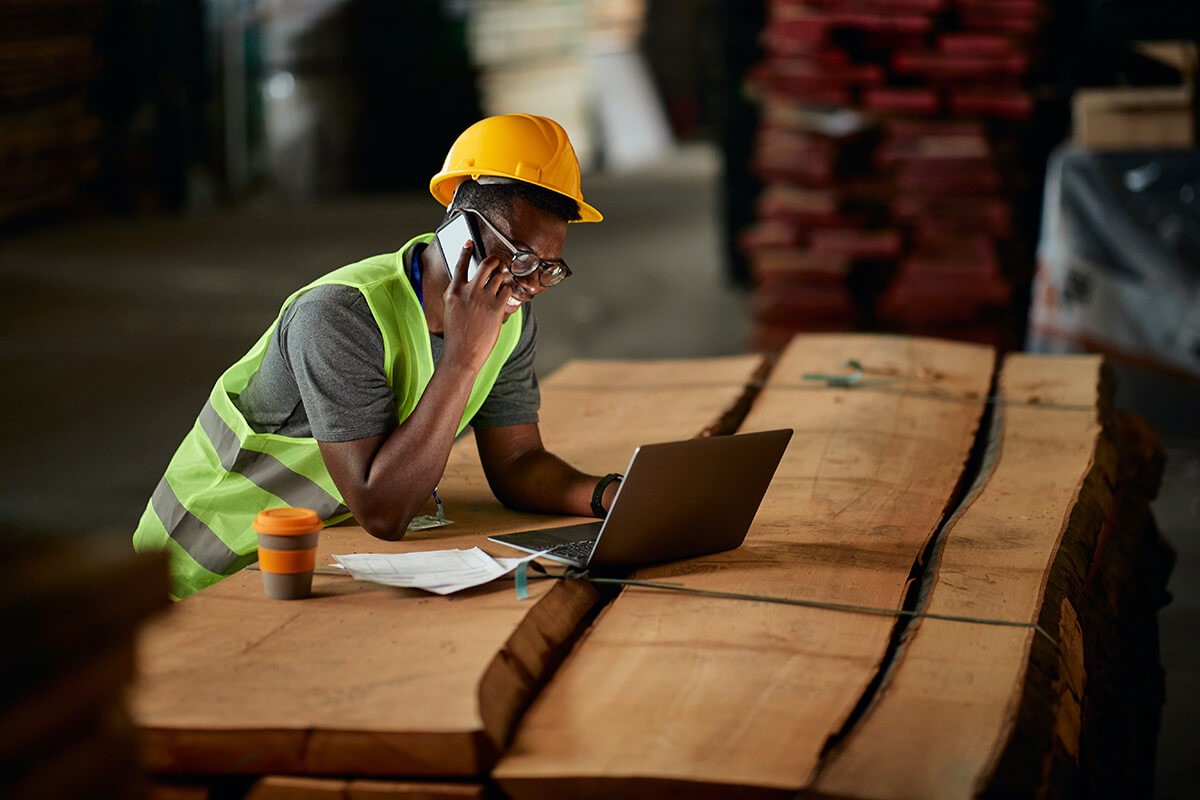
The companies in the residential home building industry have been adopting and adapting new technologies as they become more sophisticated and cost effective. These technologies aim to increase efficiency, reduce costs, improve safety, and enhance the overall project management process.
Successful single-family and multi-family condominium builders recognize the need to embrace advancements and innovative developments in the industry to stay competitive and meet the evolving demands of homebuyers and regulatory standards.
Here are some key market trends that are gaining traction and are expected to continue to improve the residential home building sector through 2026 and beyond:
1. Construction Management Software (CMS)
Home builders are increasingly using sophisticated residential construction management software to streamline operations. According to ExplodingTopics.com with an increase of 61% over the past five years alone, CMS is poised to explode in the industry over the next three years.
The construction process typically involves multiple departments, trade partners, and processes. Benefits of construction management software include features such as project scheduling, budget tracking, resource allocation, and collaboration platforms that enhance efficiency and communication among construction teams and customers.
2. Construction ERP Software
A Construction Enterprise Resource Planning system is cloud-based CMS that gathers project information for homebuilders and contractors all in one place. This Information Technology process provides everything from project delivery to resource allocation, to finances, to document management. The trend for home and condo builders to implement ERP software solutions now or in the near future is gaining traction. An Associated General Contractors of America survey found that 85 percent of construction companies are investing in this technology.
3. Remote Collaboration Tools
The COVID-19 pandemic accelerated the adoption of remote collaboration tools in the home building industry. Video conferencing, project management apps, and cloud-based solutions allow teams to work together efficiently, regardless of their physical locations.
Sales and marketing teams have also benefitted from the use of augmented reality and virtual reality technologies to virtually tour properties, electronic document processing, social media and email marketing to connect with customers remotely while moving customers through the sales-to-construction process faster.
4. Drones and Aerial Imaging

Drones equipped with high-resolution cameras are being employed for site surveys, progress tracking, and quality control. Aerial imaging can provide real-time insights into construction progress, helping builders identify issues and make informed decisions. Drones are being used to reduce waste on jobsites through building material measurement which has resulted in a 61% increase in ordering accuracy. In addition, builders are working toward reducing construction worker injuries and deaths by surveying and inspecting jobsites for potential safety hazards.
5. Building Information Modeling (BIM)
BIM technology is becoming more widespread in the home construction industry. It allows builders to create 3D models of buildings, which can improve design accuracy, reduce errors, and enhance collaboration between architects, contractors and subcontractors.
6. Sustainability and Green Building Practices
Environmental concerns are driving the adoption of sustainable building practices. Builders are incorporating energy-efficient designs, renewable energy sources, and eco-friendly materials into their projects to meet green building standards.
Integration of BIM helps drive energy-efficient construction, allows for monitoring of technical installations, and tracking energy consumption. This can help deliver sustainable and energy-efficient infrastructure. Also, it helps project supervisors conduct virtual inspections and monitor the quality of workmanship throughout the construction process.
Construction management systems can also support sustainability giving construction teams better control over waste and inefficiencies on the jobsites.
7. Blockchain for Supply Chain Management
Some residential home and condo builders are utilizing a blockchain platform to share information with other construction companies to enhance transparency and traceability in the construction supply chain. A shared digital ledger allows users to securely share a database of purchase records (blocks.) While typically used for cryptocurrencies, new uses for this technology helps ensure the authenticity of materials, reduce fraud, and improve accountability.
IoT and Smart Home Integration
The Internet of Things (IoT) is playing a significant role in modern homes. This emerging technology is based on the premise that everything is connected through the internet. Builders are integrating Smart Home technology into their projects, offering features like energy-efficient systems, security, and home automation.
Homebuyers are asking for more and more smart home technologies in new construction. By integrating these features into their homes and condos, builders can add value and appeal to the properties:
- Smart Thermostats—programmable thermostats can learn residents’ preferences and adjust heating and cooling accordingly. This can help reduce energy consumption and save homeowners money.
- Smart Lighting—allow homeowners to control lighting remotely, set schedules, and even change colors or intensity for various moods and safety.
- Smart Locks—can be controlled remotely, provide keyless entry, and offer features like temporary access codes for guests or repair services.
- Smart Security Systems—integrate security systems like Ring or Nest that include video doorbells, cameras, and motion sensors. These systems can provide homeowners with real-time alerts and monitoring.
- Smart Home Security—improves protection from intruders, fire, and theft. Includes features like sensors on windows and doors, smoke and carbon monoxide detectors, and home monitoring services.
- Smart Speakers and Voice Assistants—homes are pre-wired for voice assistants like Amazon Alexa or Google Assistant. This enables voice control of various devices and can serve as a hub for other smart home items.
- Smart Appliances—smart kitchen appliances like ovens, refrigerators, dishwashers, coffee makers, and easy-clean slow juicers can be controlled remotely, provide energy usage data, and even contact repair services when the appliance needs attention.
- Smart Irrigation Systems—adjust watering schedules based on weather conditions to conserve water and maintain landscaping.
- Smart Blinds and Shades—motorized window coverings can be integrated with home automation systems, allowing residents to control light and privacy with their smartphones and voice commands.
- Whole-Home Audio and Entertainment—homes are wired for multi-room audio and entertainment systems, allowing residents to stream music and videos throughout the house.
- Smart Garage Door Openers—can be controlled remotely and provide alerts when the door is opened or closed.
- Home Energy Management—systems monitor and optimize energy usage, such as solar panels, energy storage, and smart grid technologies.
- Smart Sensors—include things like water leak detectors and motion sensors to enhance safety and energy efficiency.
- Structured Wiring—allows for easy expansion and customization of smart home systems as technology evolves.
- Home EV Charging Stations—installation of electric vehicle (EV) charging stations in the garage to accommodate the growing demand for electric cars.
- Home Office Integration—in the post-pandemic world, many people require dedicated home office spaces. Builders should consider integrating smart technology for home offices, including ergonomic lighting and connectivity solutions.
- Energy-Efficient Construction—use of energy-efficient building materials and practices to reduce overall energy consumption of the home, making it more compatible with smart home technology.
- Future-Proofing—allows for future upgrades to ensure that the infrastructure can support new smart home technologies as they emerge.
9. Homeowner Portal

The homeowner portal is a web-based platform or application that provides homeowners with access to various services, information, and tools related to their property and homeownership. It is typically offered by property management companies, homeowners associations (HOAs), or real estate developers to enhance the community and interaction between the entities and customers. This service is especially helpful in improving customer service and the customer experience for single-family and condo owners.
Some benefits and features of a homeowner portal are:
- Homeowner account information including email addresses, phone numbers, and mailing addresses
- Online payments for association fees, property taxes, and other expenses
- Documents and announcements related to the community or property
- Maintenance requests for repairs with tracking and updates
- Community calendar for upcoming events, meetings, or community activities
- Voting and surveys for community matters and feedback
- Amenities reservations for shared amenities like a clubhouse, pool, or gym
10. Data Analytics and Predictive Analytics
Builders are harnessing the power of data analytics to optimize resource allocation, project scheduling, and cost estimation. Predictive analytics can help identify potential delays or issues before they become critical. Artificial intelligence (AI) and machine learning (ML) are being used for predictive analytics in construction, helping project managers the anticipate potential issues, optimize schedules, ad make data-driven decisions. AI-driven chatbots and virtual assistants help with project communication and management tasks.
11. Safety Technologies
Ensuring safety of construction workers is a top priority for all home and condo builders. Wearable technology, such as smart helmets and vests can monitor a worker’s health and safety in real-time, helping to prevent accidents and reduce insurance liability claims. Here are some examples of wearable safety technology commonly used in construction today:
- Hard hat with augmented reality—provide real-time information for blueprints and safety alerts displayed through a visor or heads-up display.
- Impact detection helmets—senses impacts or sudden movements, alerting supervisors or sending automatic distress signals if a worker falls or has a head injury.
- High-visibility smart vests—include embedded LED lights and sensors making workers more visible in low-light conditions.
- GPS-enabled ID badges or wearables—allow builders to track the location of workers on the jobsite in real-time.
- Wearable radios—hands-free communication devices that allow workers to stay connected and coordinate tasks with their team members while keeping their hands free for work.
Conclusion
Embracing new construction management technologies is not merely an option for residential home builders and condominium builders, it’s a strategic imperative for companies looking to thrive in the modern construction landscape. These trending technologies offer a wide range of advantages, from cost savings and efficiency gains to improved safety and sustainability practices. By integrating these tools into their operations, builders can ensure they remain competitive, resilient, and well-prepared for the challenges and opportunities today through 2026 and the foreseeable future.

